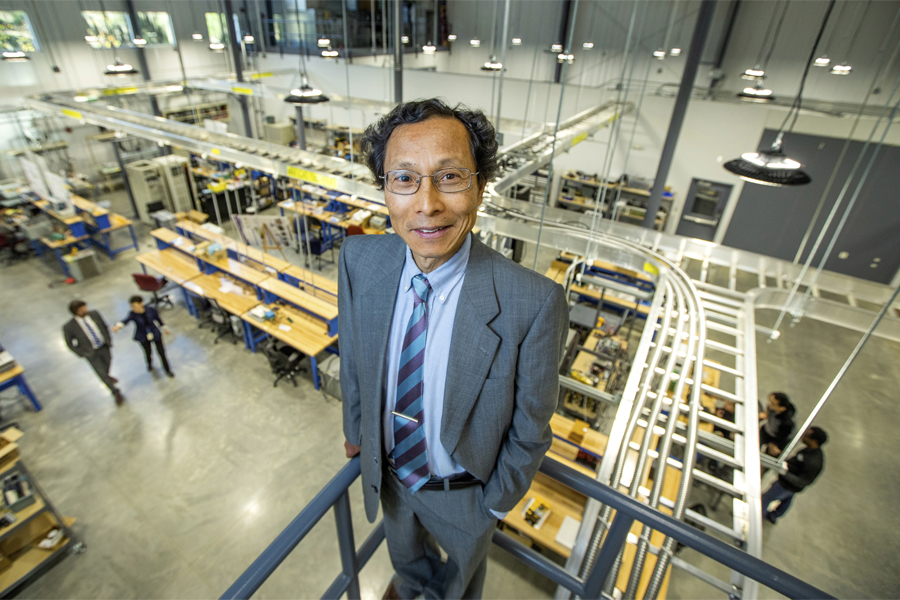
When FAMU-FSU College of Engineering Professor Fang Peng was a boy, he saw the power and peril of electricity firsthand.
He was in middle school when his remote Chinese hometown first received electric service. His family shared a single portable, 15-watt light bulb attached to a cable. It was his job to replace the bulb.
“One night, the bulb went out and I tried to change it in total darkness,” Peng said. “I accidentally stuck my left thumb in the socket and was immediately shocked. I got knocked off balance and down to the dirt floor, trembling as the electricity seared through my body. Luckily, my right hand got tangled with the cable and pulled the socket off my left hand, otherwise I would not have survived.”
After that near-death experience, Peng saw electricity as a challenge. He made it his life’s work to study the phenomenon and “tame the beast” that put him in danger but also allowed his family to see at night.
Peng’s latest research continues that mission. In a study published in Scientific Reports, he shows how a semiconductor device he created, named a Z-source inverter, can rapidly reduce voltage and current in the case of a short-circuit or open-circuit fault.
Existing safety mechanisms that stop electricity during a fault work quickly, but not always quickly enough. A typical circuit breaker could take around 50 milliseconds to activate — still long enough to kill a person or spark a fire. Peng’s digital Z-source converter/inverter can protect in 5 microseconds, or 1,000 times faster.
HOW IT WORKS
When a circuit is operating normally, power lines and cables carry electrical current over a long distance from generators to end users, whose use is called the load in an electric system. Engineers typically want it to be running as strong as possible to provide power to end users. But when something breaks or shorts the circuit, such as a downed tree, the current travels through that object. Electrical flashes that reach 35,000 degrees Fahrenheit can cause objects contacting the circuit to heat up fast and burn with intensity.
Peng’s electronic switch detects short circuits faster than existing methods. It can also handle a wide range of input voltages without needing extra components. This flexibility makes it useful in situations where the power supply isn’t constant or when you need to work with different voltage levels efficiently.
“We developed a way for the power source to be more responsive to the load,” he said. “Without end users noticing, we can immediately bring the power grid back to normal, without a surge current.”
WHY IT’S IMPORTANT
Downed power lines spark hundreds of wildfires every year in the United States. The 2023 Maui wildfires were some of the deadliest in U.S. history. According to the National Fire Protection Association, that fire started when a tree that had toppled onto a power line ignited.
“The purpose of our study is to make the energy source (voltage) more responsive to the loading condition,” Peng said. “If there is an unexpected large current, we want to reduce the voltage to a safe range to prevent fires. Traditional generators keep generating a constant voltage regardless of the current.”
RE-ENGINEERING THE GRID
Peng’s solution can be used to retrofit existing infrastructure to make it safer.
Diversifying the power grid with renewable energy sources like wind turbines, photovoltaic cells, and fuel cells is one way to regulate increases and decreases in voltage.
“Besides renewables, another way we can prevent surges in power is to artificially regulate the system with a power converter,” Peng said. “Whether natural or artificial, we want to create something that works autonomously with self-protection, resiliency and redundancy. One idea is to use a virtual resistor implemented by power electronics and control to provide the damping and stabilization of the circuit system.”
Much of the electric grid in the United States was built and expanded in the 1960s and 1970s. Along with fires from downed power lines, aging infrastructure poses other problems, such as power outages or vulnerability to cyberattacks.
“It is time to remake our grids and ‘tame the beast’ with power electronics, a new power technology which started flourishing in the 1980s when I started my research career,” Peng said. “I was truly lucky to become a protégé of several power electronics pioneers and world leaders. It takes a village to raise a child, and it takes the whole society/world to make this new grid happen.”
Peng’s research was supported by the U.S. Department of Energy and the Solar Energy Technologies Office.




